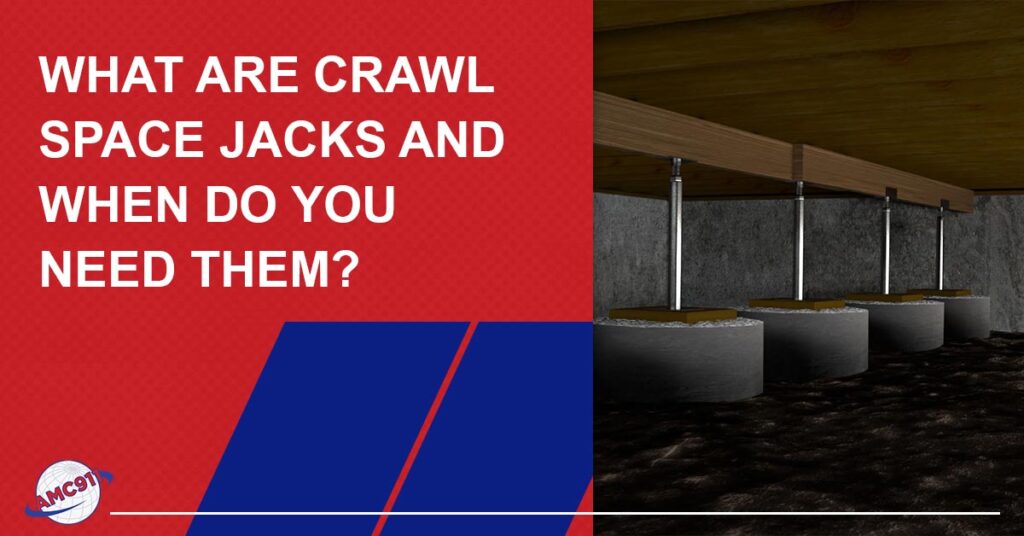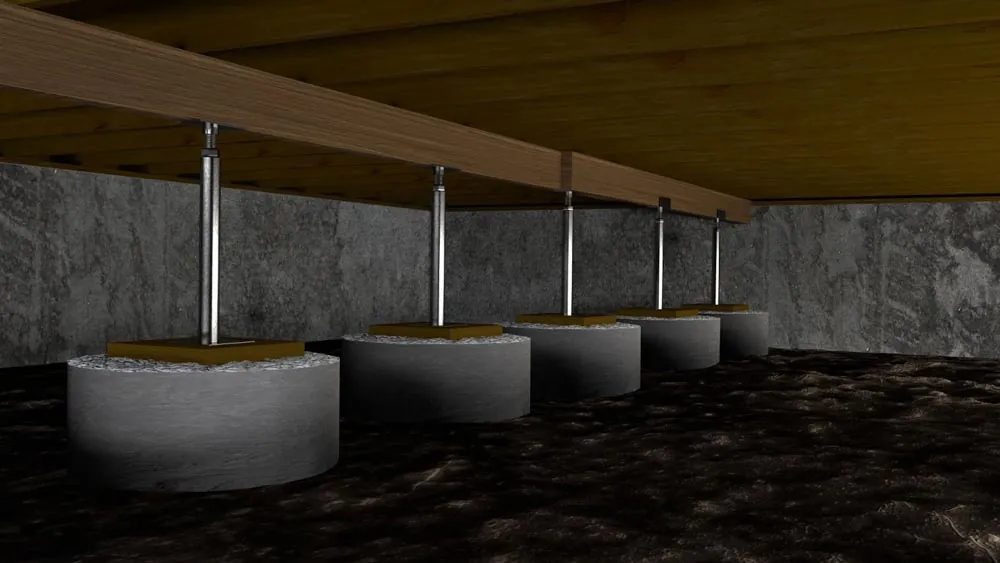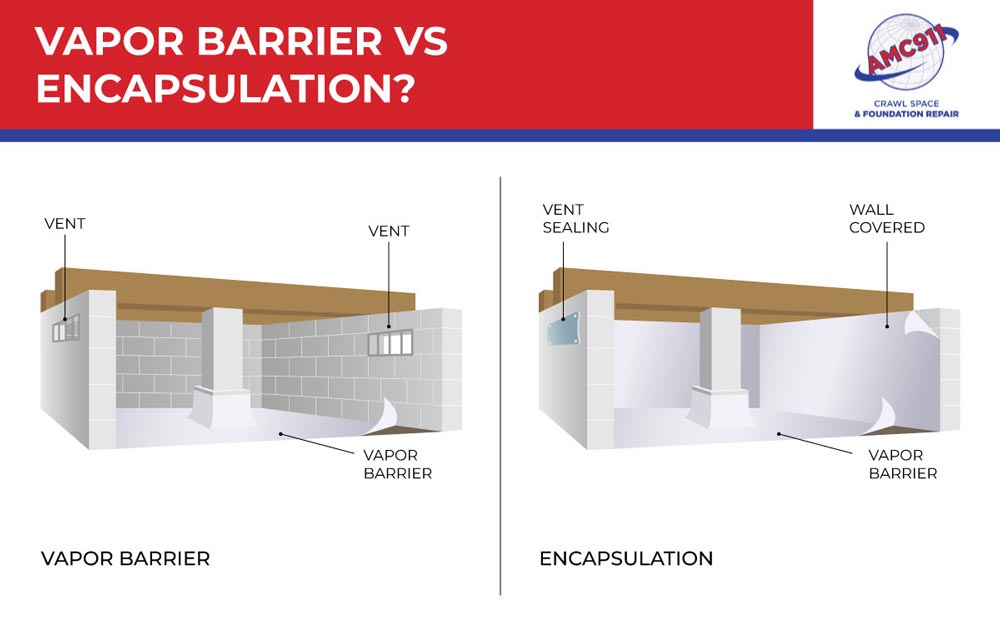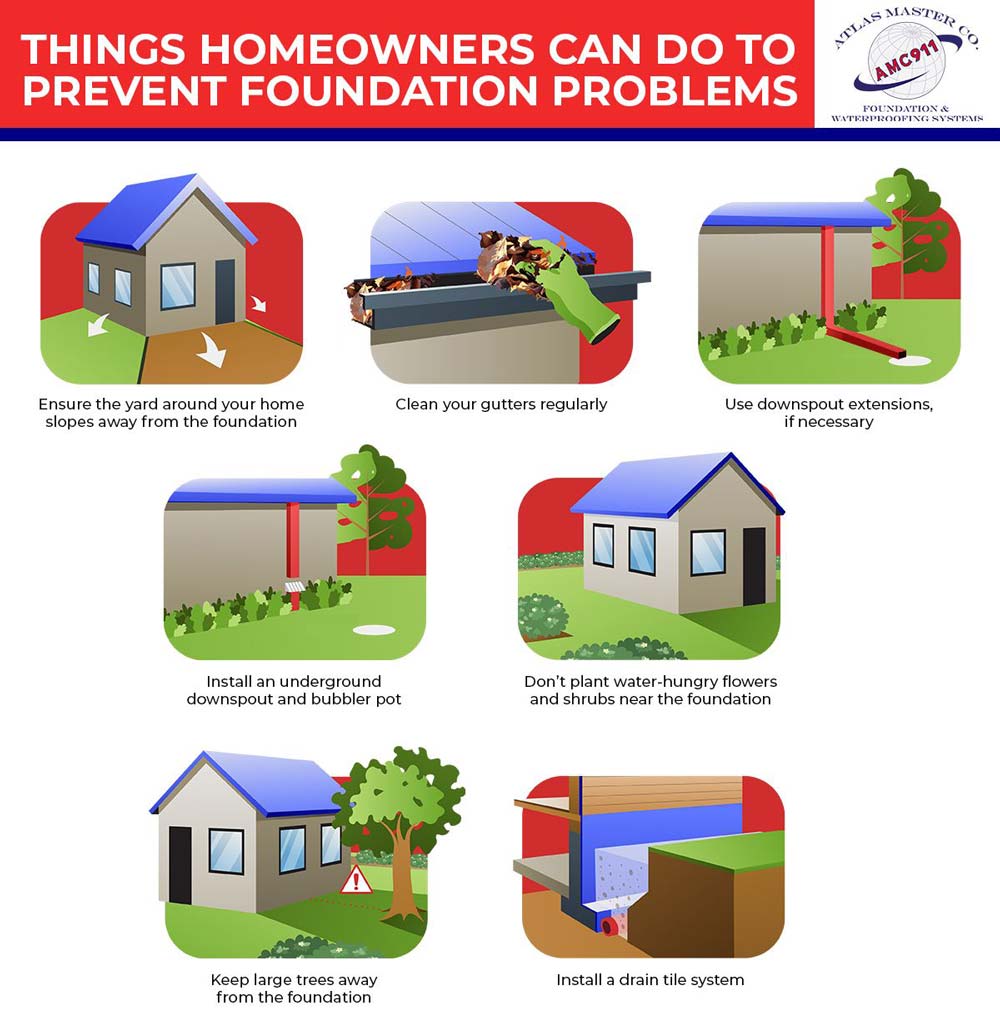Looking for information about crawl space jacks? If so, don’t hit that back button because you’ve landed on the right page. This article will review crawl space jacks, their installation, why crawl spaces sag, and more.
What’s A Crawl Space?
In a house with a crawl space foundation, the crawl space is an area underneath the building that’s typically 1.5-3 feet high. Crawl spaces allow easy access to the home’s plumbing and electrical systems.
Crawl spaces are typically used in regions with moderate to high humidity, where traditional basements would be at risk of flooding or mold growth. Crawl spaces can be insulated and encapsulated to prevent moisture buildup and ensure the area remains clean and dry. Encapsulated crawl spaces can even serve as storage areas for homeowners.
While crawl space foundations have been popular for decades, they have their downsides. One of these is their tendency to develop moisture issues. However, proper maintenance can help prevent problems.
What Are Crawl Space Jacks?
Crawl space jacks (also called screw jacks) are support structures designed to level and stabilize uneven or sagging floors. They’re adjustable and installed in the crawl space to support the beams and floor joists.
Crawl space jacks are a solution for homes experiencing structural issues due to age, settlement, or environmental factors such as mold and damage by wood-eating pests.
How Are Crawl Space Jacks Installed?
The procedure to install crack space jacks is as follows:
- Clear the crawl space of debris – Firstly, the crawl space area must be cleared of debris and any unnecessary items removed. This may include insulation, vapor barriers, and other materials.
- Place the crawl space jacks – Once the area is cleared, crawl space jacks are positioned strategically under the beams/girders to provide support.
- Adjustment – After the crawl space jacks are in place, they’re adjusted to ensure they’re positioned correctly and provide the necessary support to the foundation.
The installation process typically takes no longer than a day but depends on factors such as the crawl space’s size and the foundation’s condition.
Crawl space jacks should only be installed by a qualified professional. This is because the process involves a high degree of technical expertise and requires specialized equipment.
It’s also important to note that while crawl space jacks stabilize and level a sagging crawl space, they don’t solve the root problem. For example, did the crawl space start to sag because poor drainage around the foundation caused the dirt floor of the crawl space to become soggy, leading to the support posts becoming non-vertical? Did excess moisture in the crawl space attract wood-eating pests that led to the deterioration of the crawl space posts? Moisture is a leading cause of crawl space issues.
Why Do Crawl Spaces Sag?
Crawl spaces sag for various reasons, including the following:
- Excess moisture – One major reason for sagging crawl spaces is excess moisture. As a result, mold may grow on the wooden beams and joists supporting the crawl space. This can cause them to deteriorate, weaken and subsequently sag and bow under the weight of the floors and walls above.
- Settlement – Another factor contributing to crawl space sagging is settlement. Crawl spaces built on loosely compacted soil may cause the support posts to sink into the ground, leading to sagging.
- Damage from pests – Pests, such as termites, rodents, and insects, may infiltrate the crawl space and cause damage to the wooden supports, resulting in structural instability and sagging.
- Not enough support posts – An insufficient number of crawl space support posts can lead to many issues that can compromise the crawl space’s structural integrity. Without proper support, the crawl space will eventually begin to sag.
- Expansive soil – Expansive soil contains a lot of clay; because of this, it swells when it absorbs moisture and shrinks when it dries out. (Hampton Roads is known for having high clay content and expansive soil especially in areas like Norfolk.) This back and forth, swelling and shrinking, creates movement in the ground. If the support posts in the crawl space sit in expansive soil, they could eventually become non-vertical.
- Existing crawl space jacks have deteriorated – If crawl space jacks aren’t protected with a special coating to protect them from corrosion, moisture will eventually cause them to deteriorate. This could lead to insufficient support and a sagging crawl space.
Signs Your Crawl Space Is Sagging And Might Need Crawl Space Jacks
Signs your crawl space might need crawl space jacks include the following:
- Uneven floors
- Wall cracks
- Bouncy floors
- Furniture that shakes when you walk by
How To Help Prevent Crawl Space Problems
Fortunately, there are several ways to help prevent crawl space problems. These include the following:
- Install a drain tile system – The best way to ensure good drainage around the foundation is to install a drain tile system. Drain tile systems are designed to prevent excess moisture from building up in the ground around the foundation. This helps prevent moisture from seeping into the crawl space. Drain tile systems involve a buried perforated pipe that collects excess water in the soil and channels it toward a sump pit, where it’s then ejected away from the foundation via a sump pump.
- Encapsulate the crawl space – Crawl space encapsulation entails sealing the vents and covering the floor and the walls of the crawl space with a thick, vapor-retarding barrier. This will keep the area clean and dry and help prevent pests from entering. Adding a dehumidifier will also ensure the humidity level in the crawl space remains low.
Other things homeowners can do to help prevent crawl space problems include:
- Regrade the yard around the foundation – This involves sloping the ground away from your home’s perimeter so groundwater drains away from the crawl space. By simply adjusting the grade of your yard, you can significantly reduce the amount of moisture seeping into your crawl space.
- Clean gutters regularly – Another essential preventative measure is to clean gutters regularly. Gutters are designed to catch rainwater and direct it away from the foundation. When they’re clogged with debris, they can become a source of water damage by overflowing and saturating the ground around the foundation. Keeping your gutters clean and debris-free can help prevent excess water from seeping into the crawl space.
- Use downspout extensions – Downspout extensions are typically made of plastic or metal and attach to the end of your gutter spouts. They direct runoff several feet from your foundation before release. Downspout extensions are inexpensive, easy to install, and can save you a lot of headaches down the line.
- Keep water-hungry vegetation away from the foundation – Finally, keeping water-hungry vegetation away from your foundation can also be an effective preventative measure. You don’t want to give yourself a reason to add water to the ground around the foundation.
If you think your home might need crawl space jacks, contact AMC911 today to schedule a crawl space evaluation and receive a repair estimate.



















